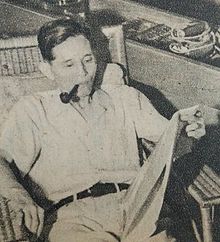Saitō Hideo
Saitō Hideo ( Japanese 斎 藤 秀雄 ; born May 23, 1902 in Tōkyō ; died September 18, 1974 ) was a Japanese cellist, conductor and music teacher.
life and work
Saitō Hiroshi, son of Saitō Hidesaburō (斎 藤 秀 三郎; 1866-1929), who drove the English lessons in Japan, belonged early to a mandolin orchestra under Hiruma Kenpachi . He received cello lessons from Ōno Motonaga (多 基 永), a member of the court office's music ensemble, since he was 16. He then enrolled at Sophia University , but dropped out because he wanted to devote himself entirely to music. In 1922 he went to Germany with Konoe Hidemaro, who was then known as a composer and conductor, and studied cello under Julius Klengel at the Leipzig Music School at the Berlin Music Academy .
In 1927 Saitō returned to Japan and became first cellist in the "New Symphony Orchestra" (新 交響 楽 団, Shin-kōkyōgakudan), the predecessor of the NHK Symphony Orchestra . He made his debut as a conductor in 1928 during the 30th season. In the same year he made his debut as a cellist and gave his first concert in 1929, which was a success. In 1930 he continued his education in Berlin under Emanuel Feuermann at the Musikhochschule in Berlin. After returning to Japan, he continued to work as chief cellist of the Shin-kōkyōgakudan.
1948 founded Saitō, supported by the composer Minao Shibata and the music critic Yoshida Hidekazu , the "music school for children". It later became the training center "Tōhō Gakuen" (桐 朋 Ausbildungs) and finally the "University Tōhō Gakuen" (桐 朋 学園 大学). There he worked as a professor, department head and finally as president.
1973 Saitō was honored as a person with special cultural merits .
His students include the cellist Tsuyoshi Tsutsumi , the conductors Seiji Ozawa and Eiji Ōue . In 1984 Ozawa brought together the "Saitō-Gedächtnis Orchester" (サ イ ト ウ ・ キ ネ ン ・ オ ー ケ ス, ラ), which has been meeting annually for concert performances since then.
Remarks
- ↑ Today a faculty of the Berlin University of the Arts .
- ↑ Klengel (1859–1933) composed a piece for 12 cellists, which has become the starting point for the current group of 12 cellists .
literature
- S. Noma (Ed.): Saitō Hideo . In: Japan. An Illustrated Encyclopedia. Kodansha, 1993, ISBN 4-06-205938-X , p. 1296.
Web links
| personal data | |
|---|---|
| SURNAME | Saitō, Hideo |
| ALTERNATIVE NAMES | 斎 藤 秀雄 (Japanese) |
| BRIEF DESCRIPTION | Japanese cellist and conductor |
| DATE OF BIRTH | May 23, 1902 |
| PLACE OF BIRTH | Tokyo |
| DATE OF DEATH | September 18, 1974 |
